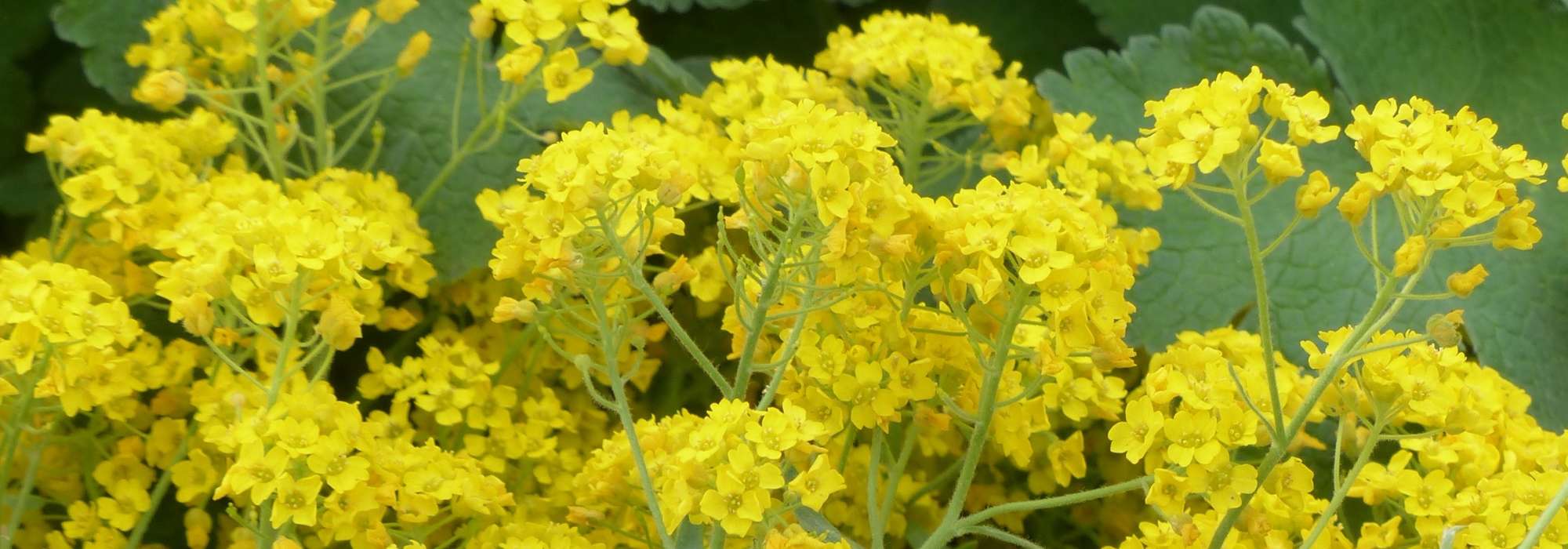
Alyssum, basket of gold: sowing, planting, care
Summary
La Corbeille d'or in a nutshell
- Basket of gold is one of the first flowers of spring!
- This perennial forms dazzling cushions of small golden-yellow flowers from spring to summer, or white in the case of white alyssum
- Undemanding, ideal for very free-draining sunny soils, even the most inhospitable
- Easy, rewarding plant that requires no care
- Hardy, tolerant of summer drought, perfect plant for rockeries, flowering walls and sunny borders; Alyssum also makes a stunning display, trailing in pots!
A word from our expert
Alyssum, Alyssum or simply golden alyssum is a rockery plant well known that offers a spring flowering so dazzling it has inspired many jewellery names!
Belonging to same family as aubrieta, genus includes some must-have species such as Aurinia saxatilis or Alyssum saxatile, golden alyssum, Alyssum montanum (“mountain alyssum”) or even white alyssum (Alyssum spinosum), all are perennials, unlike sweet alyssum or corbeille d’argent (Lobularia maritima or Alyssum maritimum) which is an annual with sometimes blue flowering.
Dry-garden plant par excellence, it grows in sun, in rockeries and over walls, to dress borders, brighten beds with its sunny flowering and even pots.
It favours poor, arid, calcareous and stony soils and its rapid growth makes it an ideal plant for new gardens or gardeners in a hurry.
Reaching 10 to 40 cm in height, it is therefore an ally for small gardens, but also brings blooms to larger borders, forming there tapetum of beautiful floriferous clumps.
To discover everything about this small perennial easy to grow and indispensable in all dry, no-watering gardens, explore our collection of golden alyssums in buckets or as seeds!
And let yourself be seduced by our perennials for rockeries, and stock up on association ideas with our Mediterranean perennials and plants for dry garden!
Description and botany
Botanical data sheet
- Latin name Alyssum
- Family Brassicaceae
- Common names Alyssum, Basket of Gold
- Flowering April to July
- Height 0.10 to 0.45 m
- Sun exposure sun
- Soil type all well-drained soils
- Hardiness down to -15°C
Alyssum, Alyssum or more commonly called Basket of Gold is a herbaceous perennial plant in family Brassicaceae like aubrietas and cabbages, naturally growing in mountainous, stony areas and rockeries of central and southern Europe, Asia and North Africa.
Genus Alyssum includes more than 150 species of annuals, persistent perennials and undershrubs including Alyssum saxatile (Aurinia saxatilis in Latin) or “rock alyssum”, which is the species most widespread in our gardens. It has given rise to several very interesting and floriferous cultivars such as ‘Goldkugel’.
Alyssum montanum or mountain alyssum and white-flowering Alyssum spinosum are also grown. Alyssums not to be confused with sweet alyssum, Lobularia maritima, more simply called “Basket of Silver”, which, although in same family, belongs to different genus and is an annual plant that flowers in summer.
Starting from a stump that becomes woody with time, this bushy herbaceous perennial spreads in mat-forming clumps, sometimes erect and more or less compact, evoking a basket. Rather low-growing, it quickly forms a good groundcover that will not exceed 10 to 40 cm in height when in flower for a spread of about 30 to 50 cm. Its rapid growth is matched only by its fairly short lifespan of about 5–6 years.
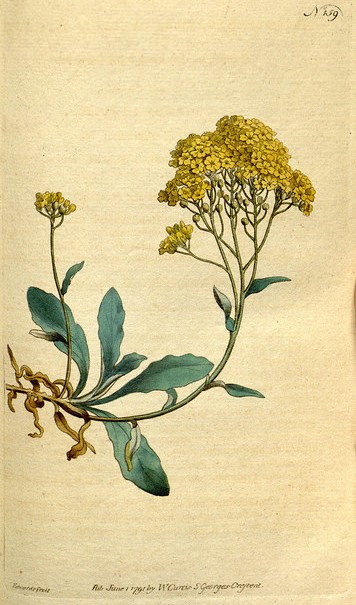
Alyssum saxatile – botanical illustration
Foliage gathered in rosettes, evergreen to semi-evergreen depending on climate severity, is arranged alternate along stems often very ramified, sometimes ending in a thorn.
It consists of small pale green leaves 0.5 to 2.5 cm long, entire, single, oblong to ovate, covered with a fine white or silvery-grey down. Some varieties such as ‘Variegata’ are variegated green and cream.
Basket of Gold is one of first flowers of spring. Its single bloom of a beautiful bright sun-yellow transforms the plant into a true basket of golden flowers, hence the name.
From April to July, this dense but rather plain foliage is hidden beneath clouds of small radiant flowers that entirely cover the mound. Gathered in numerous corymbs or dense clusters, the flowers measure 5 to 10 mm in diameter each and are made up of 4 heart-shaped petals. Some cultivars such as ‘Plenum’ bear double flowers.
From lemon-yellow to very bright golden-yellow similar to dandelion, they are very rarely fresh yellow (Alyssum montanum) or white (Alyssum spinosum).
Depending on species, they exhale a slight sweet honey scent and are all particularly melliferous, attracting numerous pollinators throughout flowering.
During summer they turn into small green round fruits, self-seeding easily wherever they fall in the garden.
Generous and undemanding, Alyssum is a really easy plant to grow in full sun in any well-drained soil, even stony. Hardy down to -15°C and beyond, drought-tolerant, it is the rockery or flowering dry-stone wall plant par excellence! Perfect for colonising inhospitable spots from spring to summer, also forming vigorous tapetum of gold or pure white in borders, path edges, containers, window boxes or stone troughs, or even installed between paving joints!
You may also read
10 drought-resistant perennial plants for gardens without wateringMain species and varieties
Alyssum saxatile (syn. Aurinia saxatilis) is the most widespread species in our gardens; it is the Basket of Gold from which interesting varieties, more compact, variegated or double-flowered, have been developed. Equally widely cultivated, Alyssum montanum, or montane alyssum, has given rise to numerous horticultural varieties such as ‘Berggold’.
Alyssum spinosum contrasts with its golden-yellow cousins by producing white flowers.
Our favourites
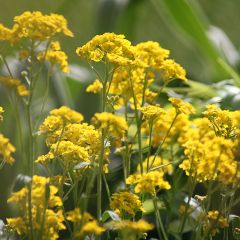
Alyssum saxatilis Goldkugel
- Flowering time may, june
- Height at maturity 25 cm
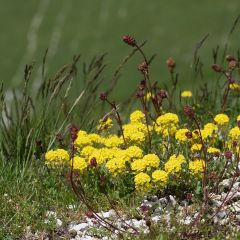
Alyssum montanum Berggold
- Flowering time june to august
- Height at maturity 15 cm
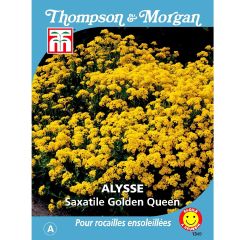
Alyssum saxatile Golden Queen - Basket of Gold
- Flowering time may to july
- Height at maturity 25 cm
Discover other Alyssum
View All →Available in 1 sizes
Available in 2 sizes
Available in 1 sizes
Available in 1 sizes
Planting
Where to plant Alyssum or Basket of Gold?
Very hardy down to around -15°C and beyond, Basket of Gold grows throughout France.
It is an undemanding rockery plant that grows naturally in poor, stony soils. It needs a sunny position and will be satisfied with ordinary, stony or sandy soil, even dry and calcareous provided it is very well drained; a relatively dry summer is always preferable to overly wet soils. This rockery plant tolerates drought well and is capable of growing in very little soil.
Basket of Gold is the perfect groundcover to brighten slightly arid areas neglected by other plants, to add flowers to a rockery or flowerbeds baked by the sun, to cascade over a dry-stone wall, to edge a path or a sunny border, or to sneak between paving slabs or into wall crevices.
It performs very well in pots, troughs or hanging baskets on sunny balconies and terraces.
When to plant Alyssum or Basket of Gold?
We recommend planting Alyssum in spring, from March to May, outside frost periods, although it is also possible to plant the buckets in early autumn.
How to plant Alyssum or Basket of Gold?
In open ground
To create a bright groundcover, allow about 5 to 7 plants per m2, spaced 30 to 40 cm apart. Alyssum prefers well-drained, rocky soils: avoid planting in soil that is too heavy or compact; in that case add coarse sand and plant on a sloping bank if soil tends to retain water.
- Dig a hole two to three times the volume of the rootball
- Thoroughly loosen the soil
- Spread a good drainage layer (gravel, clay balls)
- Place your Basket of Gold without burying the collar
- Backfill with equal parts potting compost and gravel
- Firm gently
- Mulch
- Water generously
Planting perennials well on a rockery is easy by following our tips in our video.
In containers
- Spread a good drainage layer (gravel or clay balls) in the bottom of the container
- Plant the bucket in a mixture of ordinary soil, potting compost for Mediterranean plants and gravel or coarse sand
- Water to encourage establishment then sparingly
- Place Alyssum in full sun
→ Learn more about growing Alyssum or Basket of Gold in a pot
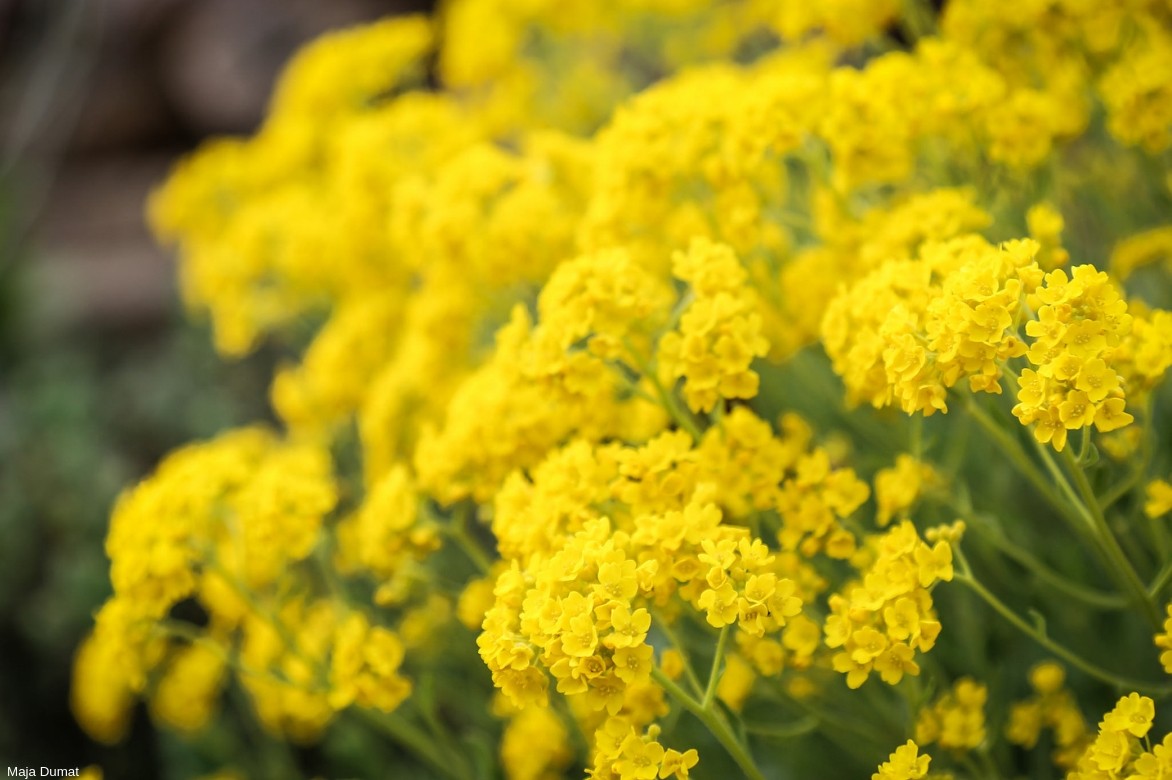
Alyssum montanum (we have the very pretty variety ‘Berggold’ in our catalogue!)
You may also read
Care of perennial plantsWhen and how to sow alyssum seeds?
Under cover
Choose golden alyssum you like from our selection of Alyssum seeds easy to sow. It’s so simple by following our tips to succeed in sowing perennial plants!
- From late March to May, at temperature of 15–29°C, sow thinly in seed tray a few seeds of golden alyssum on surface of good-quality compost mixed with sand (30%)
- Cover with 2 or 3 millimetres of compost
- Keep sowing moist but not waterlogged
- Place in light in polythene bag until germination, which takes between 8 days and 1 month
- As soon as seedlings are sturdy enough, put them into individual buckets
- Prick out at start of autumn into open ground or keep young plants in pots under cover until following spring
In open ground
- In May, sow Alyssum seeds broadcast in light, well-drained soil
- Cover with thin layer of compost
- Firm down
- Water and keep soil moist until germination
- Thin seedlings to leave 30 cm between each plant
Care and maintenance
Perfectly hardy and perennial, once well rooted in light, well-drained soil, golden alyssum requires almost no care and will do without watering. It is the ideal plant for weekend gardens!
Its preference for dry, well-drained soil makes it vulnerable to excessive watering: once well rooted in open ground, no need to water it; water only during periods of intense, prolonged drought. If you grow golden alyssum in a pot, water more regularly, allowing substrate to dry out between waterings.
No fertiliser is necessary, on the contrary, soil that is too rich would harm plant’s habit: Alyssum is an exceptionally undemanding perennial!
Pinch stems in late May to encourage plant to ramify and maintain compact growth, and cut back faded branches.
To encourage a repeat flowering, prune clumps lightly in June after first flowering.
At end of flowering, let seed set to benefit from self-sown seedlings or prune clump lightly by shortening stems by half using a pruning shear to thicken it and prevent invasive self-seeding.
After 4 or 5 seasons, clumps may lose vigour: divide them to renew plants.

Potential diseases and pests
Fairly disease-resistant, Alyssum rarely has problems. In spring, protect young foliage from slugs and snails: use fern manure to combat their attacks and follow our tips for natural control!
Soil should always be well drained; otherwise downy mildew and powdery mildew can appear in hot, wet weather, recognisable by rusty pustules or the white down these diseases leave on leaves: prune affected parts and avoid watering foliage. To prevent and control powdery mildew, follow our advice: Powdery mildew or white disease: prevention and treatment
If invaded by aphids: spray with water mixed with black soap.
Multiplication
Basket-of-gold self-seeds naturally in garden. However, you can easily propagate it from our alyssum seeds (follow instructions above). Herbaceous cuttings in June or semi-woody cuttings in August or September and division of clump at end of spring are also possible.
Divide Basket-of-gold
Divide Alyssum clumps in March on well-established stumps.
- With a spade, lift rootball
- Keep only outer offsets
- Replant immediately in garden in prepared, well-draining soil
How to take herbaceous cuttings from Basket-of-gold?
- If you have pinched stems, recover cut tips from that pruning
- Remove leaves at base of stems
- Plant them in a well-draining medium of compost and coarse sand
- Water regularly but do not overwater
- In autumn, plant out in open ground or pot on following spring
Propagate Alyssum by semi-woody cuttings
- At end of summer, take tips of stems already turning woody, from soft wood to hard wood
- Remove lower leaves
- Plant in mixture of river sand and compost
- Place cuttings in bright light sheltered from frost
- Keep substrate moist but not flooded until rooting
- Pot on cuttings into bucket
- Plant out in following spring
- Pinch stems to encourage young plants to bush out
- Water regularly for first weeks
Link
Forming brilliant golden carpets, Alyssum ‘Basket of Gold’ lets create sunny displays quickly in garden’s most unforgiving corners.
In a dry or gravel garden, Basket of Gold brings essential splash of sunshine and much-needed cheer. Its very bright yellow flowers blend into any setting, on banks, dry rockeries, sun‑scorched beds and even hanging baskets from which they will tumble in radiant cascades. They are essential in a yellow garden and in Mediterranean gardens.
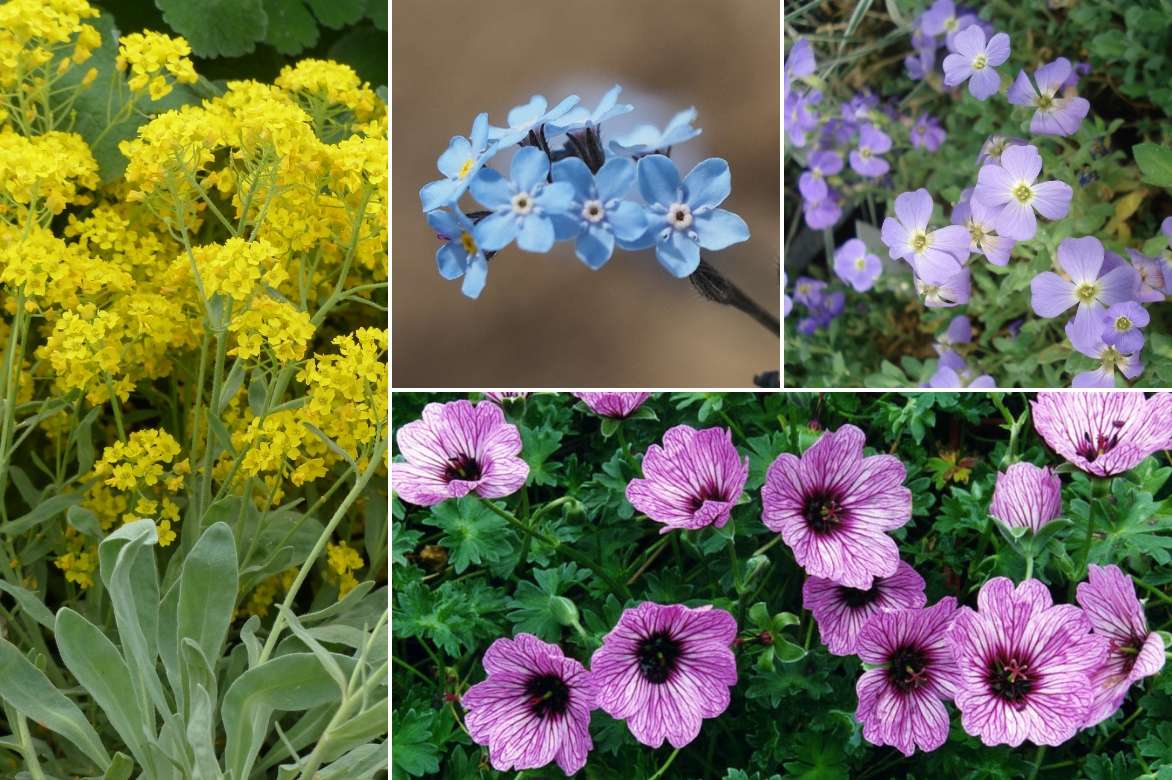
An idea for a rockery or wall association: Alyssum saxatile (‘Goldkugel’ for example), Myosotis, Aubrieta ‘Cascade Blue’ and Geranium cinereum ‘Ballerina’
Basket of Gold pairs easily with other perennial plants for rockeries, playing on blue/yellow contrasts alongside aubrietas, ageratums and rock campanulas, or violet/gold beside Spanish grass.
It is also a good companion for tulips in lively combinations.
It likes to be surrounded by Mediterranean plants equally undemanding such as santolinas, armoisies, nepetas, echinops, eryngium, Allium senescens subsp. montanum, mouse ears, helianthemum; its dandelion‑yellow flowering will wake their slightly dull foliage.
It will dress base of small bushes such as lavenders, rosemary, shrubby sages, caryopteris and the bases of hollyhocks and Perovskia.
In a mineral scene, it will stand out as pits alongside small blue‑green grasses such as fescues or with golden tones such as canche flexueuse, stipa, pennisetums.
In a sunny bed, it will work wonders alongside nemesia, cosmos, nigellas, scabious and gauras.
→ More ideas to pair alyssum or Basket of Gold in our advice sheet
Useful resources
- Alyssums can flower even during drought; to accompany them, discover 10 drought-resistant perennial plants for gardens without watering
- Are basket-of-gold plants too showy? Here are ideas to tone down yellow flowers in the garden!
- How to create a maintenance-free flower bed?
- Finest collection of perennial plants for rockery is here!
- Subscribe!
- Contents
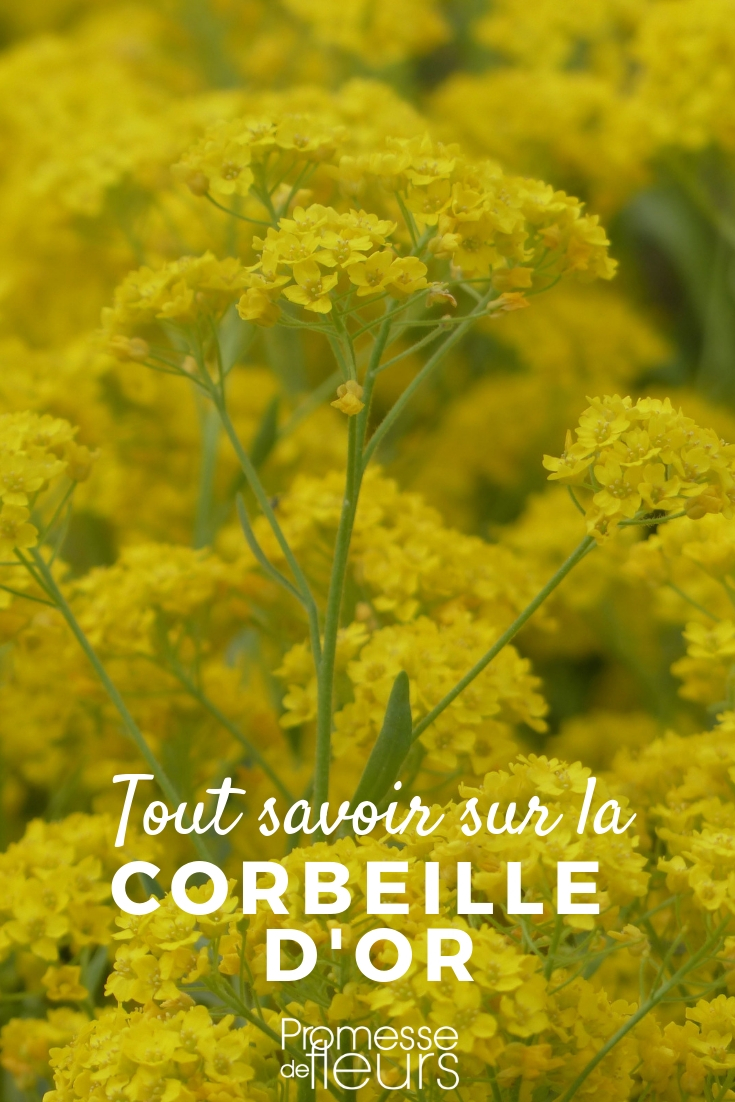































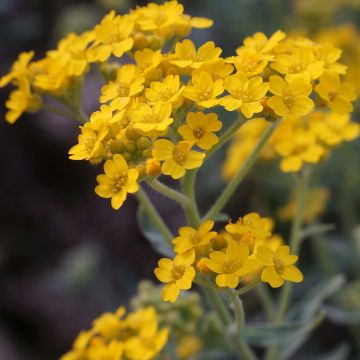



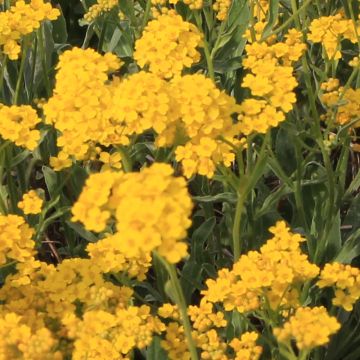
Feedbacks